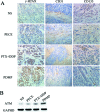Efficient inhibition of cervical cancer by dual drugs loaded in biodegradable thermosensitive hydrogel composites
- PMID: 29416613
- PMCID: PMC5787464
- DOI: 10.18632/oncotarget.22965
Efficient inhibition of cervical cancer by dual drugs loaded in biodegradable thermosensitive hydrogel composites
Abstract
Background and purpose: We aimed to explore the anti-tumor effect and mechanism of the combination of cisplatin (DDP)-containing thermosensitive hydrogel (PEG-PCL-PEG, or PECE) and paclitaxel (PTX)-loaded MPEG-PCL polymeric micelles called PDMP on human cervical carcinoma (HeLa) cell. In our previous studies, we found that PDMP in situ treatment of lung cancer will be liable to have potential in Lung cancer patients.
Results: Compared with other treatments, PDMP was most effective in prolonging survival time (P < 0.05), inhibiting tumor growth (P < 0.05), decreasing expression of CD133 (P < 0.05), CD31 (P < 0.05), and aldehyde dehydrogenase 1 (ALDH1) (P > 0.05), inducing G1 phase arrest (P < 0.05), increasing the apoptosis rate (P < 0.05), and in expressing ATM and γ-H2AX (P < 0.05).
Conclusions: PDMP is regarded as a promising anti-tumor reactant, when it comes to the treatment of cervical carcinoma.
Methods: we used a xenograft cervical cancer model to verify the anti-tumor activity of PDMP and to explore its mechanism of action. Mice were intratumorally administered with NS, PECE, PTX+DDP or PDMP. After two days of treatment, three mice per group were sacrificed and tumor tissue was harvested. Levels of histone H2AX phosphorylation (γ-H2AX) were determined by immunohistochemistry and ataxia telangiectasia mutated(ATM) protein levels were measured by western blot analysis. In addition, it would sacrifice each of group of three mice through 10 days' treatment, what's more, it would harvest tumor by virtue of flow cytometry and immunohistochemical analysis. It would like to use there maining mice to analyze tumor growth and survival. The remaining mice were analyzed for tumor growth and survival.
Keywords: cervical cancer; cisplatin; micelles; paclitaxel; thermosensitive hydrogel.
Conflict of interest statement
CONFLICTS OF INTEREST The authors report no conflicts of interest.
Figures






Similar articles
-
Novel composite drug delivery system as a novel radio sensitizer for the local treatment of cervical carcinoma.Drug Deliv. 2017 Nov;24(1):1139-1147. doi: 10.1080/10717544.2017.1362676. Drug Deliv. 2017. PMID: 28797171 Free PMC article.
-
Thermosensitive hydrogel used in dual drug delivery system with paclitaxel-loaded micelles for in situ treatment of lung cancer.Colloids Surf B Biointerfaces. 2014 Oct 1;122:90-98. doi: 10.1016/j.colsurfb.2014.06.052. Epub 2014 Jul 1. Colloids Surf B Biointerfaces. 2014. PMID: 25033428
-
Efficient inhibition of colorectal peritoneal carcinomatosis by drug loaded micelles in thermosensitive hydrogel composites.Nanoscale. 2012 May 21;4(10):3095-104. doi: 10.1039/c2nr30278k. Epub 2012 Apr 25. Nanoscale. 2012. PMID: 22535210
-
Sustained Codelivery of Cisplatin and Paclitaxel via an Injectable Prodrug Hydrogel for Ovarian Cancer Treatment.ACS Appl Mater Interfaces. 2017 Nov 22;9(46):40031-40046. doi: 10.1021/acsami.7b11998. Epub 2017 Nov 13. ACS Appl Mater Interfaces. 2017. PMID: 29131563
-
Novel composite drug delivery system for honokiol delivery: self-assembled poly(ethylene glycol)-poly(epsilon-caprolactone)-poly(ethylene glycol) micelles in thermosensitive poly(ethylene glycol)-poly(epsilon-caprolactone)-poly(ethylene glycol) hydrogel.J Phys Chem B. 2009 Jul 30;113(30):10183-8. doi: 10.1021/jp902697d. J Phys Chem B. 2009. PMID: 19572675
Cited by
-
AURKA inhibition shows promise as a therapeutic strategy for ARID1A-mutant colorectal cancer.Discov Oncol. 2024 Oct 14;15(1):556. doi: 10.1007/s12672-024-01433-y. Discov Oncol. 2024. PMID: 39402330 Free PMC article.
-
Platinum-based drugs and hydrogel: a promising anti-tumor combination.Drug Deliv. 2023 Dec;30(1):2287966. doi: 10.1080/10717544.2023.2287966. Epub 2023 Dec 11. Drug Deliv. 2023. PMID: 38083803 Free PMC article. Review.
-
Bioengineering trends in female reproduction: a systematic review.Hum Reprod Update. 2022 Nov 2;28(6):798-837. doi: 10.1093/humupd/dmac025. Hum Reprod Update. 2022. PMID: 35652272 Free PMC article.
-
Thermo-Sensitive Nanomaterials: Recent Advance in Synthesis and Biomedical Applications.Nanomaterials (Basel). 2018 Nov 13;8(11):935. doi: 10.3390/nano8110935. Nanomaterials (Basel). 2018. PMID: 30428608 Free PMC article. Review.
-
Injectable Thermoresponsive Hydrogels for Cancer Therapy: Challenges and Prospects.Gels. 2023 May 16;9(5):418. doi: 10.3390/gels9050418. Gels. 2023. PMID: 37233009 Free PMC article. Review.
References
-
- Sherris J, Herdman C, Elias C. Cervical cancer in the developing world. Best Practice & Research Clinical Obstetrics & Gynaecology. 2006;20:339–354. - PubMed
-
- Cai HB, Ding XH, Chen CC. Prevalence of single and multiple human papillomavirus types in cervical cancer and precursor lesions in Hubei, China. Oncology. 2009;76:157–161. - PubMed
-
- Waggoner SE. Cervical cancer. Lancet. 2003;361:2217–2225. - PubMed
-
- Park DC, Suh MJ, Yeo SG. Neoadjuvant paclitaxel and cisplatin in uterine cervical cancer: long-term results. International Journal of Gynecological Cancer. 2009;19:943–947. - PubMed
LinkOut - more resources
Full Text Sources
Other Literature Sources
Research Materials
Miscellaneous

